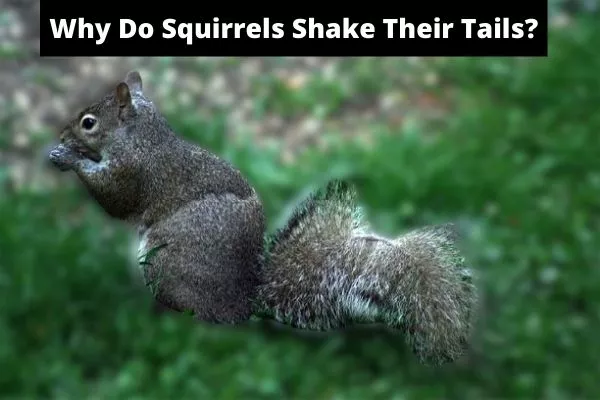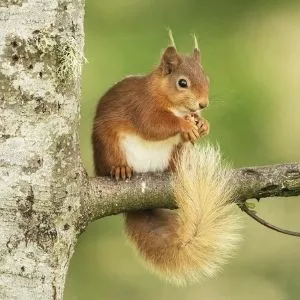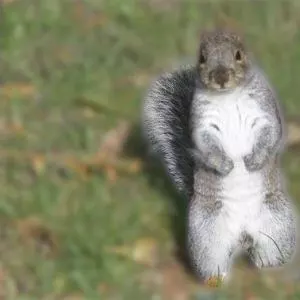Why Do Squirrels Shake Their Tails? Signals & Communication
Squirrels are adorable animals and have many different habits. One of the habits which are commonly observed is they twitch their bushy tails so often. They do it so much. If you spend time and watch them, you will notice that the twigging tail is a way of communication to them and survival strategy, and if you observe them with full attention, you will learn a lot of things from twitching their tail. But here is a question why the squirrels twitch their long bushy tails so much. The squirrels often twitch their tail when they sense danger. When they see a predator, they start twitching their tails along with loud vocalization to attain the other squirrel’s attention. The tail is a way of communication for squirrels. [acf field=”Schema”]

Squirrels also twitch their tails to show their anger and frustration. Remember that this frustration and anger are different from humans. They show their emotional state when they don’t attain anything or when they can`t solve problems. The squirrels wagging their tails may signal that they are communicating with each other, it’s a sign of frustration, territorial, sexual desires.
A few reasons why squirrels twitch their tails so much, maybe
- Help to attain others attention when they seek danger
- To attain attention from the opposite sex.
- To show frustration and anger.
- To protect the food sources and territory from rival squirrels.
- To show predators, they are aware of them.
Let us discuss some of the reasons why squirrels twitch their tails so much in detail.
Tail Twitching For Protection :
Squirrels twitch their tails when they sense danger. This is also an indication for others and predators that they are aware of their presence. The flicking motion of the tail is the best tool to inform distant squirrels to be aware of the predators and other dangers. The way squirrels wag their tail indicates what type of predator they are looking about.
Ground predators :
Most of the ground predators cannot catch animals and birds that live on the top of the tree. When the squirrels detect the predators like cats, dogs, coyotes, or even humans, they start flickering their tails and make loud vocalizations toward the source of danger.
The flickering tails inform other squirrels to locate their position and remain aware of the danger. The primary message that squirrels give is a warning. Squirrels are not worried from ground predators as the danger is on the ground and cannot harm them. So if you see a squirrel flicking its tail, try to focus on its facing position. You will quickly locate where the danger is coming from.
Aerial predator:
The squirrels are more in danger from aerial predators. The aerial predators such as hawks or owls catch them unknowingly even if they are not on the ground. The squirrels have very few chances to escape as there are very few places for squirrels to hide. Squirrels usually flatten their body with trees to hide them. In this case, there are very few chances you see the flicking of their tails. Instead, they make loud and high-pitched voices so they cannot be located.
So if you ever come across a squirrel’s high-pitched voice and cannot see a tail flicking, it means some aerial predator is nearby.

Territorial Tail Flicking :
As we know that tail flicking is an alarm to sense danger and inform other long-distance squirrels. It helps them to locate the position and help them out. However, tail flicking can be a sign of territoriality. But it should be remembered that not all squirrels are rivals to each other. For example, grey squirrels tend to live happily and are often seen feeding and interacting peacefully. They want to raise their children communally and feel safer living with others. But red squirrels and Douglass are examples of territorial squirrels. They constantly twitch their tails as a deterrent to let the others know that there will be problems for them if they invade. So be careful while making observations about territorial flicking and alarmed flicking.
Showing aggression and frustration :
Squirrels flick their tails to show aggression and frustration. This usually happens when they don’t find a solution to their problems. For example, to check their psychology, some walnuts were placed in a locked box. There was an empty box, and in one box, there was corn instead of walnuts. The squirrels showed more frustration on the locked box and flicked their bushy tails. The locked box was much more irritating than any other thing because, in the end, they returned disappointed. As they got more frustrated, they twitch their tail more. However, it should be remembered that their frustration and aggression are far different from humans.
Finding mate :
Breeding season is very interesting to watch as you can see many different behaviors of squirrels. When the breeding season starts, the male starts chasing their females around the forests. When they approach their desired female, they start twitching their tails to attract them and make them come over them. Squirrels male continue chasing the female until he catches them .When the male squirrels becomes successful in catching her . He tries to save her from other male squirrels. But sometimes the game takes turns, and the others take the female squirrel. The dominant male always won the game, and the other has to chase again for mating.
Balancing :
Squirrels required outstanding balance and flexibility for moving tree to tree, jumping on the branches either for the search of food or mating, or running from predators. They use their tail for balancing and support.
The tail continuously provides them counterbalance and momentum as they run from narrow tree branches and along powerlines. The squirrel adjusts their tail in the direction they want and assure themselves that they will not fall, but sometimes accidents occur, but tails also do work in their recovery.

Food is mine :
Whenever the squirrels find food such as nuts, fruits, etc., they immediately want to eat or store it for the winter season. Squirrels don’t want to share their food. They want to hide it from others, .so when they encounter food. They usually wag their tail to warn them not to encroach them and stay away from their food.
Squirrel swimming :
As the squirrels can do so many things, they can swim as well. The swimming of squirrels is not publically known. It is not like that they are designed for swimming, but they can swim if swimming is needed. Tail plays an important role in steering and floating when they swim.
Keep them cool :
The function of the tail is also to keep the body cool. As the squirrels keep on moving to save them from predators, their body heats up. The squirrel body has the ability to divert the blood in long bushy tails to assure that their body function properly and the tail remains them cool. Staying cold prevent squirrels’ bodies from cruel heat.
For Extra Reading: Do Squirrel Make Noise.
Staying warm :
As the winter approaches, it is much cold. The squirrels do not hibernate because they have to search for food. So in winters, they wrap their tails around themselves to feel them warm .the squirrels curl up in a small ball with a tail around them in their hand-made bed. But on the tree branches, they cannot curl up, so they lay flat with the tail on the back. You can find squirrels laying flat with a tail on the back in winters, and in hot summers, you will find the opposite position.
Bracing for a fall :
Although the squirrels are pretty good at making risky jumps and heaps, they may sometimes fall accidentally. The squirrels usually do not get bodily harm because they use their tail as a parachute for landing. The tail acts as a parachute and slows down the body as it lands and distributes its bodyweight evenly. As the squirrels are smaller creatures, they have less terminal velocity than humans to get less bodily harm.
Conclusion :
The squirrels wag their tails when they are in danger or when they are startled or alarmed. This is a signal for other squirrels to look out for the trouble and be aware of it. They usually wag their tail when they are upset. If they see any predators approaching them and their children, they twitch their tails to inform another distant squirrel. The squirrel wags their tails for territorial reasons. The other reason for wagging may be during the breeding time for mating.
Frequently asked question :
Q1:What does it mean when squirrels shake its tail?
Shaking tail is a sign of danger. When the squirrel sees anything suspicious or feels danger, they shake their tails to inform other distant squirrels. This helps them to relocate their position and help them.
Q2:How can you say that the squirrel is happy?
Squirrels show their affection by nibbling and licking. As they are wild animals, they can also show affection through biting and nibbling.
Related Post: